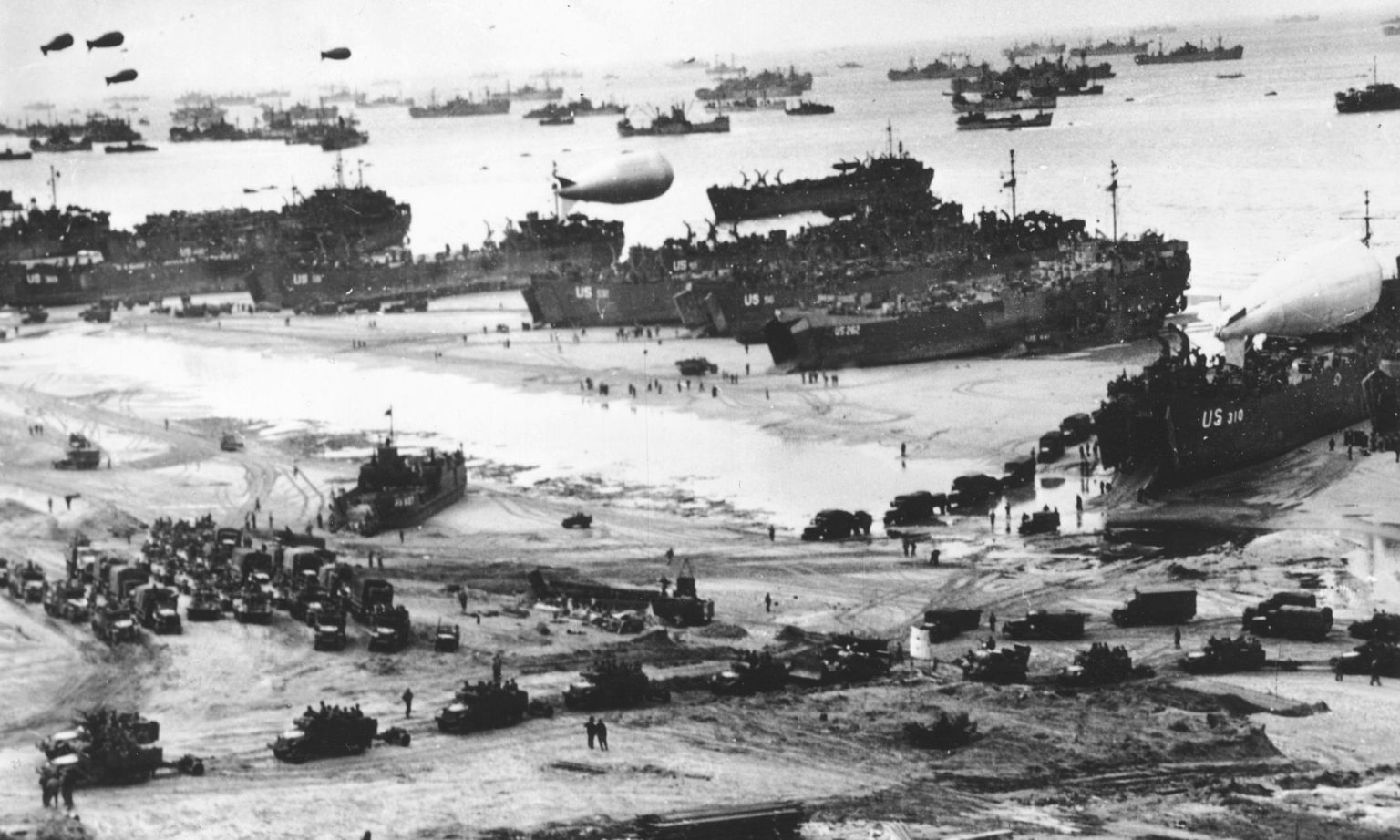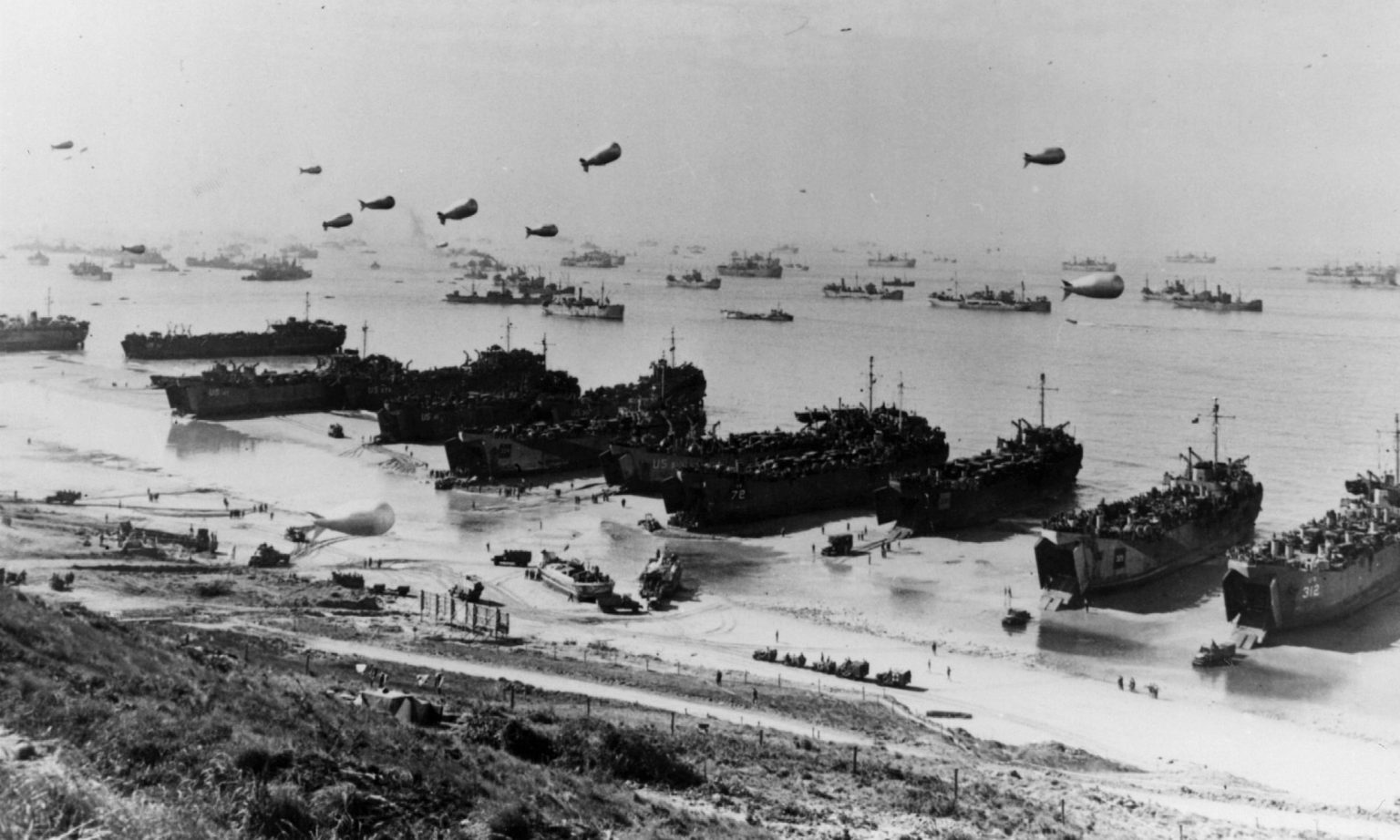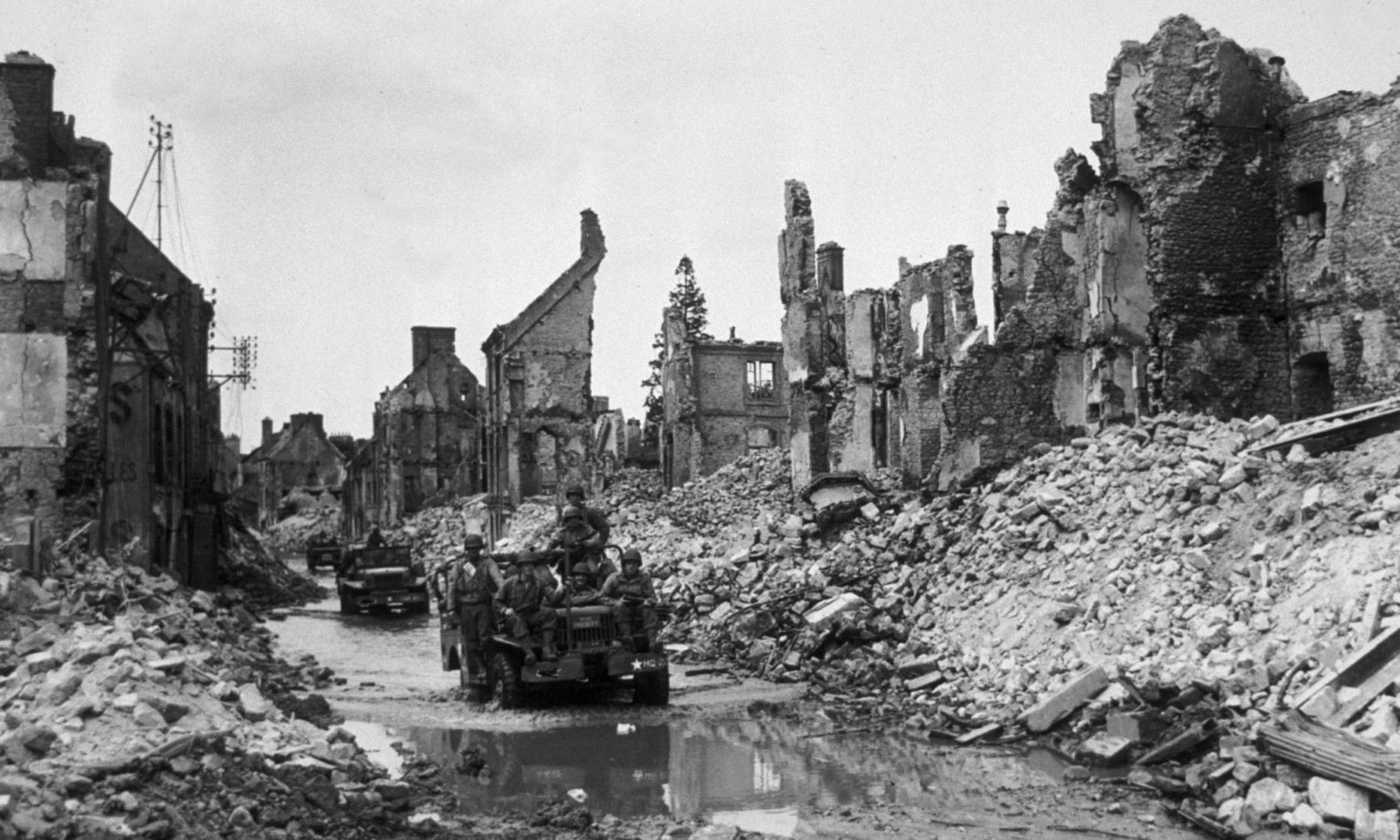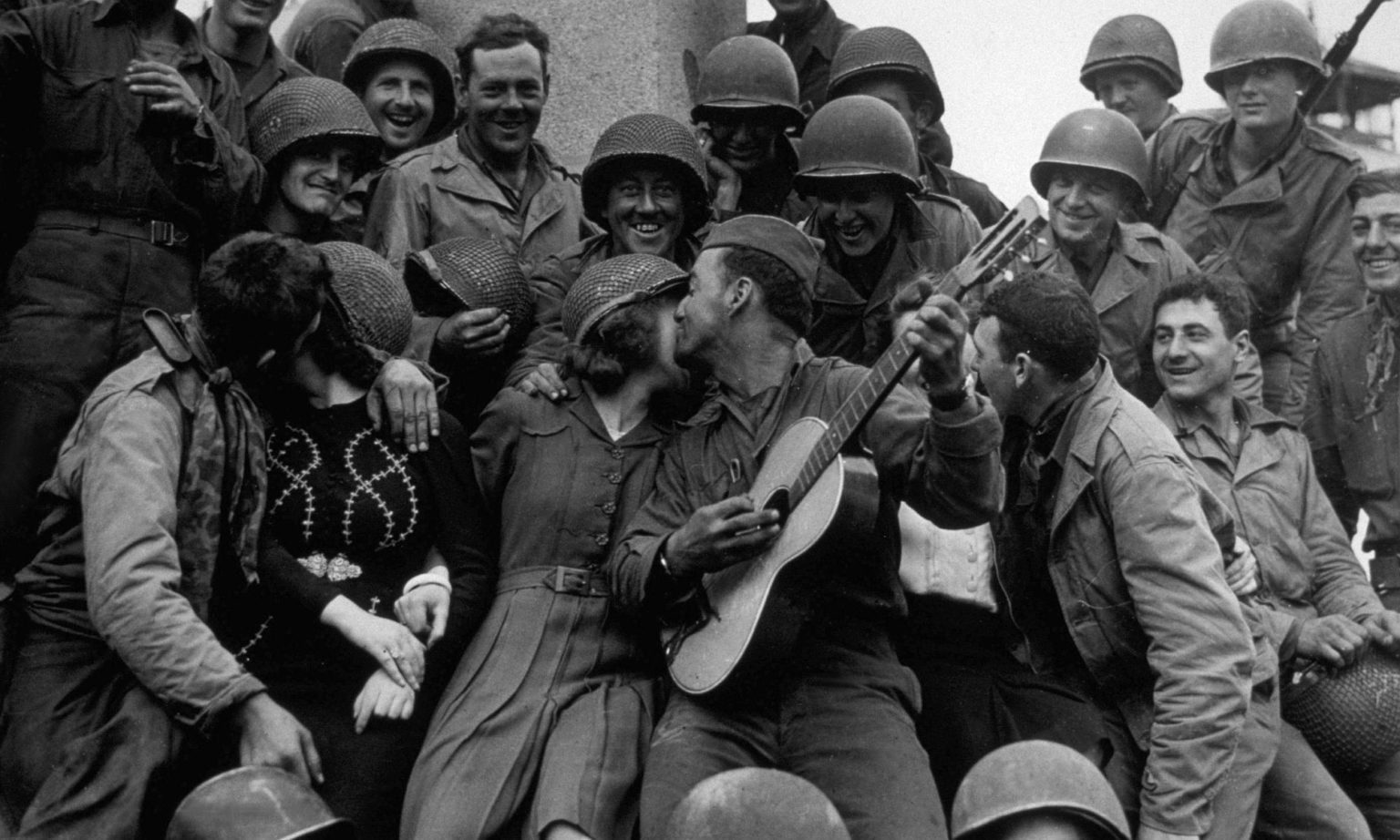
Long-read
D-Day: beyond the myth of the Good War
Seventy-five years on, let’s reckon with what really happened.
On 6 June 1944, thousands upon thousands of planes and ships bombed and shelled Nazi defences in Normandy. The Allies then sent in 23,000 men in three airborne divisions, and mounted, with 4,000 landing craft, what remains the world’s largest ever amphibious assault: five divisions, attacking five separate beaches.
Meanwhile, poorly armed but with a third of a million adherents, the French Resistance struck. On the railways, then a byword for sabotage, absenteeism and go-slow, it cut lines in 950 places; after Nazi repairs, it cut most again (1). As Anthony Beevor notes in his book D-Day, these brave moves led to the Nazis executing several hundred members of the Resistance (2). Unperturbed, the Resistance ambushed the Nazis, disrupted their telecommunications, and gave the Allies vital intelligence about them (3). Elsewhere, partisans in Italy, at the cost of 50,000 lives, pinned down eight Nazi divisions (4).
Then came Russia. Three days after D-Day, north of Leningrad, 1,600 Soviet bombers inaugurated a two-month ground offensive that helped drive Finland from the war. By 23 June, Moscow piled on further pressure with another two-month offensive in Belorussia, destroying 28 of 34 Nazi divisions there.
D-Day, then, needs to be seen from a global perspective. Accordingly, in this essay I look at some of the broad reasons for its success, before reviewing the motives for D-Day, and then contrasting Nazi military chaos with key Allied strengths. Lastly, I look at the meaning of D-Day today.
In sum, D-Day was not just a victory for Anglo-American imperialism, a relief to Russia, or a secret kept from Charles de Gaulle, France’s leader in exile, until just two days before it was launched (5). It also began the end of the Nazi yoke in Europe, saw its troops greeted as liberators, and emboldened radicals everywhere. Yet for Europe and America, D-Day ushered in not the genuine liberation of full democracy, but a new kind of top-down world. On top of further belt-tightening and plenty of repressive measures, it created a stifling unanimity around the idea that the war had been not just a military triumph, but also an unimpeachable political win for the left.
Why the invasion succeeded
With D-Day, the Allies took enormous risks. Defence, after all, is usually a stronger position than attack. Though the Allies were aided by weather stations in the western Atlantic, predicting the necessary low cloud cover, low winds and calm seas was tricky. These were just two of the many reasons why General Eisenhower, the Supreme Allied Commander, famously drafted a mea culpa ‘in case of failure’ letter, dated 5 July.
In Why the Allies Won, Richard Overy concedes that the Allies had population numbers and raw-materials tonnages on their side, and, in 1943, had built 151,000 aircraft against the Axis powers’ 43,000. However, for Overy it was the speed and scale of American rearmament that really decided things. That, and the Soviets’ regrouping, rearmament and implacable land campaigns.
After 1942, Overy continues, Anglo-American forces prevailed on sea and in the air. Like Russia, they fielded improved aircraft, tanks, mobilisation technologies and training, eventually beginning to match the Nazis’ level of combat effectiveness. Last, and a big part of such effectiveness, was the political dimension of warfare. As Overy emphasises, ‘The war was never, in reality, a simple war of good against evil, or civilisation against Dark Age, but the Allies’ ability to make it seem so simplified their war aims and cemented a domestic and international consensus in their favour’ (6).
Among all the factors behind VE Day and VJ Day, this political dimension was the most critical. And it was critical, too, to the outcome of Normandy.
Normandy was touch and go. One cannot agree with America’s reactionary chronicler of the war, Band of Brothers author Stephen Ambrose, that it ‘all came down to a bunch of 18- to 28-year-olds’. Yet still, there is something in his hint that it could have gone either way. Indeed, after three months casualties roughly balanced: the Wehrmacht lost nearly 250,000 men outright and another 200,000 to captivity, while the British, Canadians and Poles lost 83,000; the Americans, more than 125,000, and Allied airmen, another 17,000 (7).
Nazi forces were encumbered by 67,000 horses. Relentless Allied bombing of Germany meant that it could only muster 170 planes, of which just two got to the Normandy beaches in daylight. The Nazis were made weak in mines, reinforcements, equipment, half-tracks, spares (especially tyres), repairing and fuel. Despite all this, however, the defenders’ commander, Field Marshall Erwin Rommel, still started with 34 divisions against the Allies’ five, and continued to outnumber Allied divisions until well into June. His 120,000 garrison troops were poor, and many of his divisions depleted. Yet though weary from previous campaigns, many of his soldiers were more experienced than the invaders, and ready to fight without air support or artillery.
The numbers and hardware unveiled by the Allies were visibly astounding. Yet it was the Soviet masses, the Resistance and, above all, politics that helped most. Significantly, too, these primary reasons for D-Day’s success lay to one side of the combat at the cliffs. Today, 75 years later, they have faded into relative invisibility.

One rarely hears it now, but Hitler’s primary target was always Moscow. Thus, in 1944, the Axis had 180 full divisions and 60 weaker ones on the Eastern Front; but at D-Day, it mustered just 58 for the whole of France and the Low Countries (8). Moreover, Soviet successes from January to May – incursion into Poland, lifting of the siege of Leningrad, arrival at Romania, conquest of the Crimea – built up political pressure on Washington and London to open a Second Front against the Nazis. So, too, did heavy fighting by the French Maquis (the rural, guerilla branch of the Resistance) in March, the growth of Committees of National Liberation in Italy, and the rise of the National Liberation Movement (ELAS) in Greece (9).
All this didn’t just hearten many of the Normandy landers. It also made their political leaders realise something important. Delaying D-Day had both made military sense, and conveniently dragged out the mutual destruction of Nazi and Soviet forces. Now, though, Europe needed invading, if only to save it from a revitalised left.
In this regard, the political superiority of democracy over fascism worked wonders at D-Day. On its eve, British troops asked labour minister and top trade union boss Ernest Bevin: ‘Ernie, when we have done this job for you, are we going back to the dole?’ Bevin’s reply, and that of Winston Churchill, was ‘No’ (10). That was a reply that was believed.
While the Nazis fought the putative annihilation of Germany, Allied troops fought for a better world. Yet, if unemployment in Britain was reduced to just two per cent and less after the war, it was achieved under a Labour government that initiated strike-breaking, enforced austerity, and implemented food rationing that continued to 1954.
For Overy, the Allies’ war did make democracy more secure in the West. But as he observes, democracy was restricted in Britain and America during the war, and, after 1945, had ‘at best a chequered career’ elsewhere (11). In fact, the same can also be said for democracy in postwar France, Italy and Greece – and, more recently, for democracy in Britain, too.
The motives behind D-Day
It is perhaps too easy to be cynical about Washington and Whitehall. No doubt some in high places there genuinely wanted to rid Europe of Nazi oppression. However, many more mixed ideals with cynical self-interest. Anglo-American disputes over Normandy confirm this.
Especially given Churchill’s disaster at Gallipoli (1915-16) and his backing for a disastrous test raid by Canadian and British forces on Dieppe (August 1942), Britain’s elite was more cautious than America’s. Helped by a strong Navy, but hindered by a weak economy, limited manpower and earlier wartime reversals, London favoured careful seaborne incursions against the Nazis in southern Europe – a ‘peripheral’ strategy, not a concentrated assault on heavily defended France (12).
America’s rulers were different. Compared to the Brits, they were fresher to the struggle, blessed by a strong economy, and possessed of a bigger tradition of land war. Instead of attrition, they favoured a knockout punch. Since July 1941, US planners had banked on vast forces on land and in the air. After 1943, they felt that naval transports, their defence and their contents should be focused on the Atlantic, British ports and British military bases, and on northern France – the shortest route to Berlin. The US war effort was to be concentrated there, and nowhere else (13).
Further tension divided Britain and America. Churchill’s fondness for Mediterranean raids reflected his concern to preserve gateways to the Raj in India, British oilfields in the Middle East, and the Empire in Africa. By contrast, Washington aimed to dominate not just Germany, but all of continental Europe… and Britain. It wanted Britain to decolonise India, exit Palestine and end its influence in Saudi Arabia and Australasia. America succeeded in all these objectives (14). And about Africa, FDR hinted that British power should end, denouncing British conduct in the Gambia, for instance, as ‘just plain exploitation’ (15).
So it was that in August 1943, at the Quebec Conference, America managed to push a reluctant Britain formally to agree to Operation Overlord, which D-Day kicked off. At the conference, Britain also submitted to the secret Quebec Agreement on joint atomic weapons research – a deal that also stipulated no British use of the bomb without America’s consent. On top of that, the Quebec Agreement gave Roosevelt what historian and biographer Graham Farmelo nicely sums up as ‘an unprecedented veto’ over Britain’s future commercial development of atomic power (16).
That was not all. America outwitted Britain at the November 1943 ‘Big Three’ conference in Soviet-occupied Teheran. Because Britain’s leaders resisted Overlord, FDR connived with Stalin to get Churchill to reverse that policy.
There was one more key aspect of American power. By 1944 Lend Lease, through which America lent a bankrupt Britain $30 billion with which to buy US goods and weapons, had emerged as a device to stop Britain discriminating against non-Empire imports (not least, American ones). Indeed, Lend Lease also compelled Britain to sign up to the ‘largely American’ drafts of provisions founding the International Monetary Fund and the World Bank (17). These provisions accompanied America’s Bretton Woods agreements for managing the world’s money (22 July).
All these moves consolidated America’s power over Britain. Washington’s decision for and control over the invasion of Normandy reflected the fact that it had usurped London’s role in the world long before the landings.
Whatever Washington had in common with London in the fight against the Nazis, Normandy helped it cut Britain down to size. These things are worth remembering today, when Labour and Liberal Democrat critics of US President Donald Trump drone on about how Britain must not be a ‘poodle’ to America, and contenders in the Conservative leadership contest eulogise Britain’s ‘special’ relationship with it. Well ahead of Normandy, Britain had clearly become the unmistakable poodle in the relationship.
Nazi chaos
In Overlord, Max Hastings argues that the Führer’s manic suspicion of his generals, and his divide-and-rule management of them, made for cumbersome command structures in France (18). Hitler refused to allow Rommel to move his fearsome Panzer tank divisions to the coast, and, as Beevor notes, drove senior officers to distraction by being obsessed with every detail. Worse, he vetoed what Field Marshall Gerd von Rundstedt wanted: ‘a slow retiring action’ (19) – a fighting retreat of the type the Wehrmacht had made from Russia. Instead, Hitler insisted that, no matter what the odds, his troops should always hold their ground.
Such interference and adventurism were indeed damaging. But, beyond just Hitler, the Nazis’ were by this time unable to obtain the weapons they needed. That, military historian Azar Gat and others acknowledge, was partly due to the ‘structural problems of competing authorities inherent in Germany’s totalitarian regime’ (20). However, Gat misses the point when he adds that Germany and Japan’s new regimes were more inspiring, and their soldiers tougher, than those of the democracies, which were ageing and ideologically defensive.
Certainly, France had collapsed ‘like a pack of cards’ in 1940 (21). But first, the merits of Nazi troops over American ones are at least debatable (22); and second, the delusional fanaticism of Hitler could produce only ridiculous results. Rommel denounced the concrete-and-steel Atlantic Wall, which reputedly ran coastal fortresses from Spain to Arctic Norway, as Hitler’s cloud-cuckoo land; it was a construction which Rommel inspected, but Hitler did not. Similarly, Hitler stuck to his belief that Normandy was only a feint, designed to divert attention from planned landings at the Pas de Calais, right up until 7 August, less than three weeks before the liberation of Paris (23).
In contrast to the Nazi chaos, the Allies’ political systems could count on what US General Maxwell Taylor later described as ‘that wonderful flexibility and self-confidence imparted by democratic society’, and what Ike called ‘the fury of an aroused democracy’ (24). In turn, that fury was relatively sober, and, so long as it did not get turned against its commanders, all the more useful for that reason. Moreover, for all their upstaging of the British, neither FDR nor Ike consciously organised rivalries among their generals the way Hitler did.
Nazism, then, was not just beaten by America’s GDP. Reaction also undid it. Conversely, democracy, though severely constrained, benefited the Allies.
The Allies were utterly rapacious. Churchill left three million Indians to starve. America’s rulers were wholly racist in their conduct with black troops and their internment of Japanese-Americans. On 25 July, American planes used napalm and fragmentation bombs in France (25). During and long after 1945, America protected and colluded with top Nazi scientists and Nazi intelligence chiefs (26). When US president Harry S Truman told Labour prime minister Clement Attlee that the US Air Force was ready to drop an atomic bomb on Japan, Attlee ‘had no difficulty with Truman’s decision’ (27).
For all this, though, the Allies’ political systems were more militarily efficient than fascism. At Normandy, that counted for a lot.
Allied strengths
Air power was central to the Allies’ success. By 1944, the US was manufacturing 8,000 planes a month. In March, P45 Mustang fighters neutralised 60 per cent of their Nazi equivalents; on 5 April, they destroyed 53 planes (28); importantly, too, they helped Allied bombers eliminate Germany’s synthetic oil facilities, which accounted for most of its fuel supplies. In May, Allied aircraft smashed 75 bridges and tunnels connecting Normandy with the east, effectively ruling out an immediate Nazi counter-attack.
It is easily now forgotten how much air power aided the Allies at the beaches. Yet, again rather off-stage, other factors counted enormously, too. Baldly put, they were three: supply, innovation and subterfuge.
Through all-out drives in recruitment, procurement, production, transport, logistics, apparel, medicines and food, a third of a million Allied civilians performed miracles of supply. Thus, up to mid-June, the Allies moved to Normandy 19 divisions, half-a-million men, 77,000 vehicles, and 22,000 tons of supplies a day.
To do all this meant a certain amount of operational give and take among the organisers. It is true that Allied orders existed to execute paratroopers who refused to exit the C-47 transporter planes bound for Normandy (29). Yet an occasional willingness to compromise inside the Allies’ apparatus was useful against the full-on dictatorship of Nazism.
In Allied factories, however, few compromises were made. Thus, in March 1944, when hundreds of members of the United Auto Workers at a Pratt & Whitney engine plant in Detroit rioted after two were dismissed for smoking, UAW leaders denounced and betrayed them (30). This was a pattern repeated in Britain. It foreshadowed postwar labour relations in both countries.
What about innovation? Despite the Nazis’ belated development of V1 unmanned aircraft, V2 rockets, jets, ground-to-air missiles and stealthy long-range submarines, their over-rigid subordination of Germany’s much-reduced cadre of strictly non-Jewish scientists to the military stood in sharp and ineffective contrast to Allied R&D. In tanks and what Churchill termed, in his book The Second World War, ‘synthetic harbours’ (vast concrete constructions known as Mulberry), the democracies achieved many highly practical breakthroughs in engineering and product design. Thus, historian Scott Addington usefully observes, perhaps the most important of the Allies’ landing craft, the 12-knot, 328-feet LST, could carry up to 20 Sherman tanks (31).
The Allies’ subterfuge consisted of astonishing feats of deception, secrecy and signals intelligence. When they dropped 300 fake parachutists, which were in fact exploding scarecrows, on Normandy, most Nazi commanders again took that as merely a diversion from the Pas de Calais. More importantly, before D-Day, fake camps, ships, planes and radio signals, along with inflatable tanks and even fake tank, truck and gunfire noises, spoofed German military intelligence. Germany’s intelligence organisation, the Abwehr, came to believe that massive armies lay in Britain’s south-east, bound for the narrow waters between Dover and Calais. Meanwhile, the Allies concealed the assembly of real forces in Britain’s south-west, and supervised almost complete silence: all Atlantic communications were cut, and three million troops were denied contact with locals.
The secrecy was formidable. Popular support for the struggle made civilians’ inevitable presentiment of the invasion a thing kept within Britain. As a result, the Nazis had no idea when the enemy would come.
Rommel did suspect some kind of Allied move on Normandy. As a consequence, he insisted on an uncharacteristic diffusion of German forces, not their concentration. That proved deadly.
So, too, at Bletchley Park, Buckinghamshire, did Britain’s success in breaking the codes of German Enigma machines. Codebreaking allowed the Allies to know both the Nazis’ order of battle, and ‘exactly how the Abwehr was responding to some planted falsehood, or beginning to suspect one of the [Allies’] bent or invented agents, or setting up a scheme for infiltrating a fresh agent’ (32).
To repeat: the democracy of the Allies was not as democratic as many hoped. Yet in terms of military cohesion, supply, technology, trickery designed to maximise surprise and, above all, political motivation, it won out over Nazi self-belief. That self-belief led Berlin, while it spread its own forces thinly, into imagining that the Allies would follow German practice and put all their forces at one spot – the Pas de Calais. This was a blunder of epic proportions.

The Nazis were also torn apart by feuds. One was the internal war between the Abwehr and the SS. Another was exemplified by the Nazis’ chief of intelligence on the Western Front, Baron Alexis von Roenne. He had only contempt for Hitler’s unbridled optimism; so he fed Berlin with systematic exaggerations of Allied numbers. In Berlin, that reinforced the idea that even a diversionary attack by the Allies on Normandy meant that the Nazi war machine would still have to get stuck in there — either to prevent what would at least be a big propaganda coup for the Allies if a landing was able to hang on, or to defeat such a landing and thus inflict a big military and political disaster in the Allies. As a result, the Nazis increased the fatal dispersion of their forces (33).
Conclusion
As it happens, my uncle, Tony Richardson, was at Gold Beach on D-Day. At 21, he commanded a troop of Essex artillerymen. Seeing other, often grossly overburdened soldiers floundering in the sea, he told the skipper of his landing craft: ‘Run this thing up the beach. I’m going ashore dry.’ That way, he and his men could run and fight freely in dry clothes, not constricting wet ones.
I always disagreed with his politics. But whatever else is said about D-Day, it’s hard to see his presence of mind and his laconic sang froid much in evidence today.
Whatever else is said, too, the scale of organisation shown by Britain before and after D-Day, and its coordination with Resistance and Soviet forces abroad, was remarkable. Once again, though, things now stand differently.
The British establishment cannot and will not organise anything like D-Day. While it has repeatedly warned that a ‘cliff-edge’ Brexit would turn this country’s south coast into one great chaotic disaster of a lorry park, it cannot now dwell too much on how, in 1944, 175,000 invaders and their 10,000 vehicles were first kept hidden from Nazi eyes, then kept continuously supplied with food, fuel, spares and reinforcements across the Channel. In 2019, critics of Brexit believe that to highlight such prowess merely amounts to nostalgia. But the prowess is a fact, and gives the lie to Project Fear. It underlines, too, how far the organisation and resolve of British capitalism have collapsed in three-quarters of a century.
Nor, today, does the establishment even know who to coordinate with internationally. It cannot decide between Washington and Beijing; and from Labour leader Jeremy Corbyn to the Liberal Democrat leader of Portsmouth City Council, much of it resents Trump’s visit even more than British leaders resented America’s control of Overlord in 1944.
Nevertheless, the establishment feels obliged to say something about D-Day. But what? Since 1945, a general War of the Anniversaries, as spiked regular James Heartfield has lampooned it, has made the political spins put on D-Day say more about their creators than they have about the event itself. As a result, the 75th-anniversary retrospective will not just be vaguer than previous ones about the precise achievements of D-Day, but also more awkward, more embarrassed.

From D-Day through to August, the Allied campaign destroyed Hitler’s forces on the Western Front, made them flee for the first time in their career, and sealed the Führer’s fate. But it did more than that. From Cornelius Ryan’s The Longest Day in 1959 to Stephen Spielberg’s Saving Private Ryan in 1998, books, films, footage and stills about Normandy naturally, but one-sidedly, highlight the sacrifices made by the poor bloody infantry. Always they go back to the view, from landing craft, of obstacles and carnage on exposed beaches, complete with dark skies above and dark seas below. The upshot is that the infantry’s outstanding heroism in the sand has come to look like the very face of democracy on the march – gritty, magical, noble, all-conquering. In comparison, all the other factors behind success at Normandy, though still mentioned, have receded, from Washington taking over the show, to the speed-up in the factories, to the slaughter from the skies, to the feats of supply, innovation and subterfuge. Backed by an FDR radio prayer given on the evening after the invasion had begun, Normandy to this day serves as a poignant tableau conveying the unalloyed perfection of American and British democracy.
The reality was very different. To take a key case in point: British official resistance to the Holocaust was ‘at most a secondary aim to be realised only if it would in no way impair the resources required for the central objective of British victory over Germany’ (34). And, like Allied motives, Allied tactics were far from pure.
As an example of ‘excessive civilian casualties’, Beevor insists, Normandy was ‘outstanding’: FDR rejected the pre-invasion concerns Churchill had about such casualties. Before D-Day, and through our old friend collateral damage, the Allies killed 15,000 French and injured 19,000 more; in and after D-Day, they killed 20,000 more civilians (35).
Despite all this, elites have used Normandy to neuter radicals, cover over imperial designs, and present imperial politics as progressive. In his explanation of Allied victory, Ambrose gives a list of many of the factors that we have described here, only to conclude it with what he calls ‘the cooperation of business, government, and labour in the United States and the United Kingdom – all summed up in the single word ‘“teamwork”’ (36). But such teamwork put democracy, the working class and the left at the mercy of business and government. In the US, it opened the way to McCarthyism.
As Angus Calder’s The People’s War has it, civilians in Britain cheered troop convoys on at D-Day, as if it were ‘a Dunkirk in reverse’ (37). Today, the civilian side of D-Day preparations is still remembered; but the British elite paints the courage shown on Normandy’s beaches as the emblem of the Good War. Little wonder it will not mark next year’s anniversaries of Hiroshima and Nagasaki like it does D-Day. For those twin atrocities undermine what D-Day has been made to represent – namely, the Allies as an untainted force for liberation.
The varied nationalities among the Allied forces seem to underline this Good War thesis, for Normandy was, Beevor contends, ‘the most multinational clash of the whole war’. The participation of women in the Allied war effort also still looks good. But looks can be deceiving. For while Ike said he could not have won the war without women, they joined blacks and Japanese-Americans in being strictly segregated from the mainstream forces of the US military.
Along with Stalin’s pre-war vacillations on Nazism, his Gulag system of forced labour camps and his murderous purges of opponents, the prestige of D-Day for the Western Allies ensured that any leftist critical of Ernest Bevin, minister for labour during the war, and Labour foreign secretary after it, or of the American Federation of Labor and Congress of Industrial Organizations in the US, was for years ostracised. As the Good-vs-Evil cartoon of democracy against fascism morphed into an equally reductive cartoon of democracy against communism, Russian casualties were forgotten, while those of the French Resistance became mired in a mixture of myth and personal vendettas.
All too often, the iconography of D-Day and the beaches has obscured what really happened. Without diminishing the human qualities that were evidenced 75 years ago, now is a moment not to celebrate, but to take off the mask. D-Day shows that true democracy is always something that has to be fought for.
James Woudhuysen is visiting professor of forecasting and innovation at London South Bank University. He is also editor of Big Potatoes: the London Manifesto for Innovation. Read his blog here.
(1) ‘What good did resistance do?’, by MRD Foot, in Resistance in Europe: 1939-45, Stephen Hawes and Ralph White (eds), Pelican, 1976, p211
(2) D-Day: The Battle for Normandy, by Anthony Beevor, Penguin, 2019, p46
(3) Partly because it lacked ammunition, the Resistance’s intelligence and sabotage helped Normandy more than its guerrilla actions on troops: Beevor, p45. Even Alan Milward, a sceptic about the Resistance’s impact on his home turf of economics, logs how on 14 July, Resistants captured Puy-les-Vignes, Limousin, the top French mine extracting precious wolfram, from which tungsten for Nazi armour and armour-piercing munitions was made. See ‘The economic and strategic effectiveness of resistance’, in Resistance in Europe: 1939-45, Stephen Hawking and Ralph White (eds), Pelican, 1976,, pp193-194
(4) This was a creditable eight divisions out of a Nazi total of 26. The Second World War: An Illustrated History, by AJP Taylor, Purnell Book Services, 1975, p192
(5) Roosevelt and de Gaulle: Allies in Conflict, by Raoul Aglion, The Free Press, 1988, p166. When Eisenhower issued a printed and broadcast proclamation to France that deliberately omitted de Gaulle and the Free French, de Gaulle unilaterally withdrew the 200 French liaison officers who were to embark with and help the Normandy landings. pp168, 169. Churchill became so angry with De Gaulle that he wanted him flown back to his base in Algiers – ‘in chains if necessary’. D-Day: The Battle for Normandy, by Anthony Beevor, Penguin, 2019, p21
(6) Why the Allies Won, by Richard Overy, WW Norton, 1996, pp2, 4, 5, 18-21; quotation from p23
(7) D Day: June 6, 1944: The Climactic Battle of World War II, by Stephen E Ambrose, Simon & Schuster UK, 2016, p25; D-Day: The Battle for Normandy, by Anthony Beevor, Penguin, p522
(8) The Second World War: An Illustrated History, by AJP Taylor, Purnell Book Services, 1975, p188; Why the Allies Won, by Richard Overy, WW Norton, 1996, p154
(9) See An Unpatriotic History of the Second World War, by James Heartfield, Zero Books, 2012, pp272, 274-5, 276, 283
(10) Quoted in The Road to 1945, by Paul Addison, Cape, 1975, p242
(11) Why the Allies Won, by Richard Overy, WW Norton, 1996, p2
(12) Ike’s amphibious and successful invasions of North Africa, Sicily and Salerno failed to assuage British nerves about amphibian warfare. In these three episodes, defender fortifications were missing – in a way they were not at Dieppe and Normandy. D Day: June 6, 1944: The Climactic Battle of World War II, by Stephen E Ambrose, Simon & Schuster UK, 2016, p39
(13) ‘Winston Churchill and the “Second Front”: a reappraisal’, by Tuvia Ben-Moshe, The Journal of Modern History, Vol 62, No 3, September 1990, p510
(14) ‘The wartime Anglo-American alliance’, by David Reynolds, in WM Roger Louis and Hedley Bull (eds), The ‘Special Relationship’: Anglo-American Relations Since 1945, Clarendon Press, 1986, p29. The American historian John Lewis Gaddis records that the US decided that it would assume ‘global responsibilities’ in Asia in 1943, and in Continental Europe during the summer of 1944. The Long Peace: Enquiries into the History of the Cold War, by John Lewis Gaddis, OUP, 1989, p24
(15) At a press conference in February 1944, FDR described his reaction to Britain’s conduct in Africa after a stopover in Gambia on the way to the Casablanca conference the previous month. The British, he concluded, took better care of their livestock than they did the Gambians (the latter had a life expectancy of 26 years). Cited in The United States and the End of British Colonial Rule in Africa, 1941–1968, by James P Hubbard, McFarland, 2010, p6
(16) Churchill’s Bomb: A Hidden History of Britain’s First Nuclear Weapons Programme, by Graham Farmelo, Faber and Faber, 2014, p241
(17) ‘The wartime Anglo-American alliance’, by David Reynolds, in WM Roger Louis and Hedley Bull (eds), The ‘Special Relationship’: Anglo-American Relations Since 1945, Clarendon Press, 1986, p32
(18) Overlord: D-Day and the battle for Normandy (1984), by Max Hastings, Pan, 2015, pp63-64; Beevor, p223
(19) Quoted in The War 1939-45, Volume 2, Desmond Flower and James Reeves (eds), Panther, p504
(20) War in Human Civilisation, by Azar Gat, OUP, 2006, p563. Along with competing authorities, the Nazi war machine suffered from a very bureaucratic HQ. When, told of enemy activity in Normandy, the commander of the top SS division Hitler Jugend asked his superiors’ permission to move forward, his frustrated tank crews ‘spent many hours waiting in their vehicles until Führer headquarters finally agreed to release them for action’. Beevor, p55.
(21) War in Human Civilisation, by Azar Gat, OUP, 2006, p564.
(22) D Day: June 6, 1944: The Climactic Battle of World War II, by Stephen E Ambrose, Simon & Schuster UK, 2016, pp52-53
(23) D Day: June 6, 1944: The Climactic Battle of World War II, by Stephen E Ambrose, Simon & Schuster UK, 2016, p63; Why the Allies Won, by Richard Overy, WW Norton, 1996, p164
(24) Quoted in D Day: June 6, 1944: The Climactic Battle of World War II, by Stephen E Ambrose, Simon & Schuster UK, 2016, pp53, 57
(25) Why the Allies Won, by Richard Overy, WW Norton, 1996, p208
(26) In his obviously unreliable book published after the war, Eastern Front intelligence chief General Reinhard Gehlen wrote, about him handing over his network of Nazi spies to Washington in the anti-communist cause: ‘It was very much to the credit of everybody concerned on the American side that they were able to find the right psychological basis and the climate of mutual trust for the launching of this unique venture’. The Gehlen Memoirs, by Reinhard Gehlen, Collins, 1972, p138
(27) Reported in Cabinets and the Bomb, by Peter Hennessy, OUP/British Academy, 2007
(28) P51 Mustang, by Michael F Jerram, Haynes Publishing Group, 1984, p42
(29) D-Day: The Battle for Normandy, by Anthony Beevor, Penguin, 2019, p28
(30) Labor’s War at Home: The CIO in World War II, by Nelson Lichtenstein, CUP, 1982, p191
(31) Invasion! D-Day & Operation Overlord in One Hundred Moments, by Scott Addington, Uniform, 2019, pp125-7
(32) Ultra Goes to War, by Ronald Lewin, Arrow edition, 1980, p306
(33) Hitler’s Spies, by David Kahn, Arrow edition, 1980, pp477-8. Kahn highlights the Nazis’ weak codebreaking, and, rather tellingly, attributes the failure of German intelligence in the War to five factors: ‘(1) unjustified arrogance, which caused Germany to lose touch with reality; (2) aggression which led to a neglect of intelligence; (3) a power struggle within the officer corps, which made many generals hostile to intelligence; (4) the authority structure of the Nazi state, which greatly impaired its intelligence; (5) anti-Semitism, which deprived German intelligence of many brains’, p506
(34) Britain and the Jews of Europe 1939-1945, by Bernard Wasserstein, OUP, 1988, p320
(35) D-Day: The Battle for Normandy, by Anthony Beevor, Penguin, 2019, pp49. Looting and unnecessary damage by Allied troops also helped ensure that their vast presence in Normandy, Beevor says, ‘felt oppressive’, pp519-520
(36) D Day: June 6, 1944: The Climactic Battle of World War II, by Stephen E Ambrose, Simon & Schuster UK, 2016, p57
(37) The People’s War: Britain 1939-45, by Angus Calder, Cape, 1969, p55
To enquire about republishing spiked’s content, a right to reply or to request a correction, please contact the managing editor, Viv Regan.







Comments
Want to join the conversation?
Only spiked supporters and patrons, who donate regularly to us, can comment on our articles.